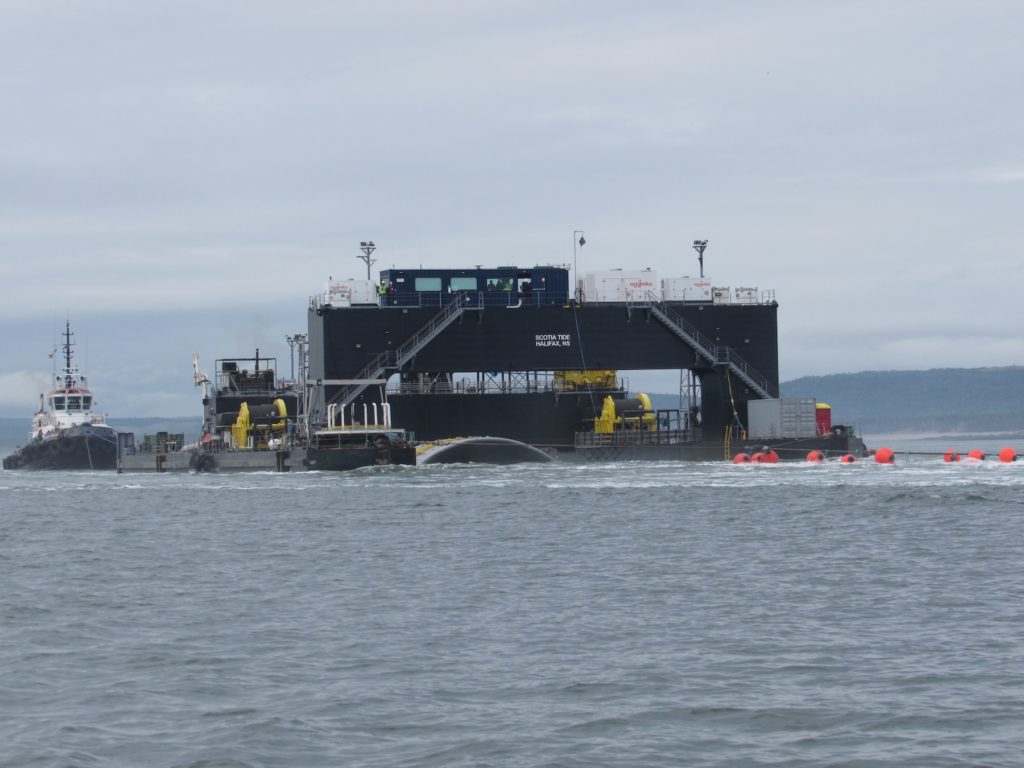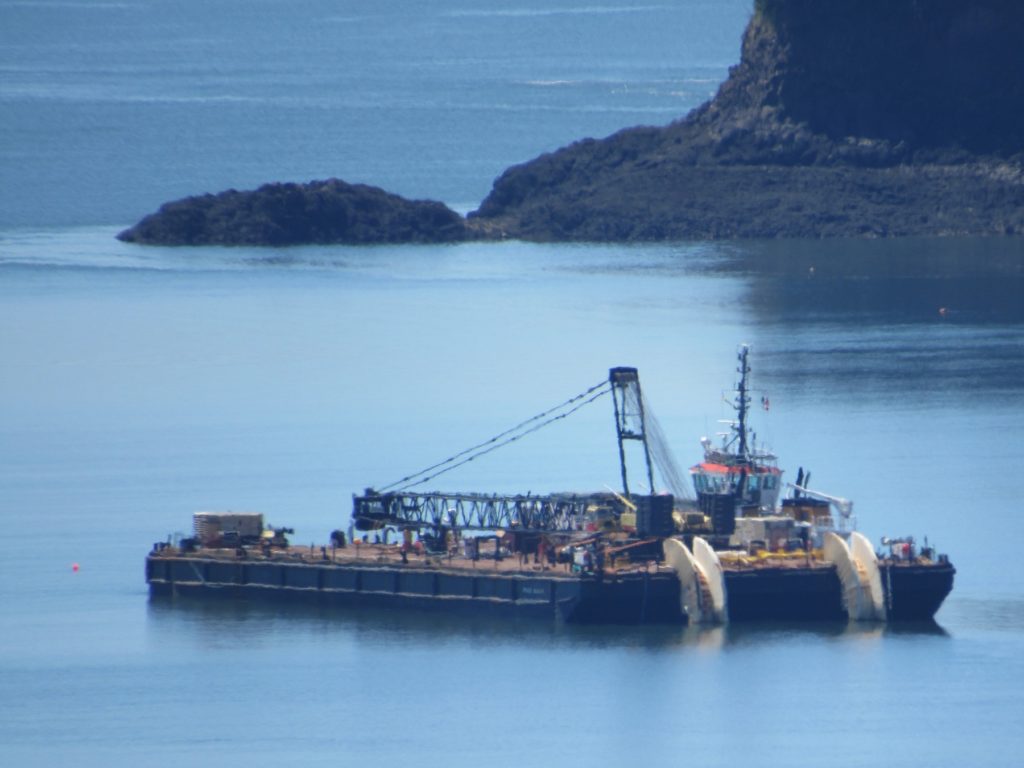
Cape Sharp Tidal Turbine sinks into the Bay of Fundy’s Minas Passage, July 22nd. The OpenHydro designed Scotia Tide barge was built in Pictou, Nova Scotia.
The tide turned on OpenHydro, the first company to launch a turbine in the Minas Passage in Nova Scotia’s Bay of Fundy. (The first attempt was in 2009 when OpenHydro partnered with Nova Scotia Power deploying a smaller open centre turbine).
The high cost of being the first pioneering tidal energy development company to successfully deploy, grid connect, and retrieve more than one turbine at this site, oft referred to as the Mount Everest of tidal, could sink the Dublin based OpenHydro group, an 80% Cape Sharp Tidal partner with Halifax Headquartered Emera, holding the other 20% interest in the Cape Sharp Tidal Venture.
The OpenHydro group needed 1 million Euros per week to stay afloat, reports today’s Irish Independent newspaper. That’s about 1.5 million in Canadian dollars.
“Emailed invoices are bouncing back.,” said one local tourism operator today.
Some Parrsboro businesses are left with unpaid bills from last spring. One innkeeper hasn’t been paid for their last two stays. The owner didn’t book OpenHydro this time in peak season. “They couldn’t commit to exact dates.”
The High Court of Ireland has appointed provisional liquidators to Dublin – based OpenHydro Group Lt. and it’s subsidiary OpenHydro Technologies Ltd., after being told both companies were “seriously insolvent” with debts of approximately 280 million Euros, according to the Irish Independent Newspaper.
The team in the Cape Sharp Venture lowered a massive in- stream, 2 MW open centre turbine, together with it’s subsea base, onto the ocean floor at their berth, near Black Rock, about ten kilometres from Parrsboro, Nova Scotia last Sunday. Four days later an application to wind up the Irish based companies was made by parent Naval Energies, which the Irish High Court heard is the largest shareholder and creditor of the OpenHydro group.
On Monday, questions to the onsite staff at the tax payer funded Fundy Ocean Research Centre of Energy (FORCE) Visitor’s Centre about whether the grid connection targeted for that day was completed, as the Irving Beaver Barge slipped out of site towards it’s mooring in West Bay early afternoon, were directed to the communications person offsite who could only be reached by email.
On Tuesday, the ‘dry’ grid connection was completed within the acceptable tidal window, aboard the Irving Beaver Barge pictured below.

The Irving Beaver Barge designed to enable the ‘dry’ (out of the water) connection from the subsea cable to land. Atlantic Hemlock alongside. – Lynn Sawyer

Explanation of the various components of the subsea cable.
The ‘dry’ grid connection was completed aboard the Irving Beaver Barge, in West Bay, Nova Scotia followed by hugs and high fives between workers involved, two days before the High Court of Ireland appointed Grant Thornton as provisional liquidators, to Dublin based OpenHydro Group and it’s subsidiary Open Hydro Technologies Ltd. The court heard Irish headquartered OpenHydro’s French parent Naval Energies, which had invested 260 million Euros in the money loosing operation, no longer wanted to support the pre-commercial venture.
On Thursday, the day after a key Naval Energies engineer involved in the Bay of Fundy grid connection flew back to France, an application to wind up the Irish based companies was made overseas by OpenHydro’s parent Naval Energies, which the High Court of Ireland heard is the largest shareholder and creditor of OpenHydro Group, reported Ireland’s Independent newspaper.
The decision came as a shock to OpenHydro’s staff, reported the Irish Times, citing industry sources.
Local sources in town had the same impression, “They were blindsided.”
The ripple effects are as far reaching as the tides, profits of some Nova Scotia and New Brunswick small businesses could sink.
One owner, staring at unpaid invoices said, “They’ve pulled out of town. Hopefully Parrsboro businesses will be compensated.”
“There would have been a bond posted for this project. That is a requirement,” Nova Scotia’s new Energy Minister Derek Mombourquette, three weeks into the job, told CBC’s Jean Laroche. He said he only learned the news on Thursday himself.
“It’s really a corporate issue,” said Mombourquette, “Ultimately, you have a private company that is going through this process. They’ll have to determine the best path forward for them with their receivers,” he told Laroche, adding he is still optimistic about tidal energy in Nova Scotia.
Ocean Energy Europe Chief Executive Remi Gruet said on Twitter that although the liquidation was “disappointing news,” closures are “part of pioneering and innovating in a brand new industrial sector, on the road to commercialization.
Naval Energies CEO Laurent Schneider-Maunoury told CBC’s Laroche, “The problem is, the cost of producing tidal power far outstrips the price anyone is willing to pay for that electricity.
In early June Schneider-Maunoury told Patricia Laurent with a Green Business publication in France, www.greenunivers.com , “We need a quick decision from the State. We are waiting for decisions from States, especially France, for commercial farms (tidal arrays).” (Note : The article published on June 11th in www.greenunivers.com was translated from the French for the English author of this article).
Naval Energies acquired OpenHydro in 2013, and opened a new tidal turbine factory in France with great fanfare on June 14th, with only two orders, one of them for Canada, confirmed by www.greenunivers.com .
Naval Energies, blamed a “deterioration in the market” and a lack of commercial prospects in the long term” for the decision to pull funding this week. Ms Justice Costello, in the Irish Court, adjourned further proceedings to a date in August, reported the Irish Times.
According to Cape Sharp spokesperson, Stacey Pineau in an email, “there is a statement that Emera issued late Thursday.”
“We understand that a petition has been filed in Ireland for creditor protection. We are taking the time to understand what this means for the Cape Sharp Tidal project and we are working to get a better understanding of next steps.”
